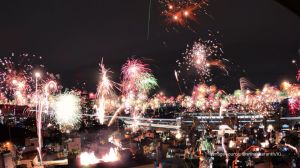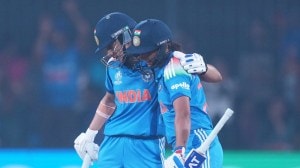Delhi’s monsoon misery puts BJP’s ‘triple-engine’ govt to the test, gives AAP fresh ammo
After assuming full control over Delhi’s governance in February, the BJP promised to end waterlogging. But waterlogged roads, tragic deaths, and a political blame game paint a different picture.
 Waterlogging at Dhaula Kuan led to kilometers of traffic congestion after rain, at New Delhi on Thursday, August 14, 2025. (Express photo by Abhinav Saha)
Waterlogging at Dhaula Kuan led to kilometers of traffic congestion after rain, at New Delhi on Thursday, August 14, 2025. (Express photo by Abhinav Saha)Every spell of rain in Delhi brings the same scenes — knee-deep water, stranded cars, fallen trees, and electrocutions. But this monsoon, the downpour comes with an unusually high dose of political voltage.
Both the ruling Bharatiya Janata Party (BJP) and the opposition Aam Aadmi Party (AAP) have gone at each other hammer and tongs after every rain this season.
That’s because for the first time in 25 years in the national captial, the BJP controls both the Delhi government — after sweeping the 2025 Assembly polls — and the Municipal Corporation of Delhi. The Delhi L-G and his Office are also on board.
In the city, different agencies manage different drains — sometimes even different parts of the same drain — without any coordinated action. These include the Public Works Department (PWD), the Municipal Corporation of Delhi (MCD), the Delhi Jal Board (DJB), and the Irrigation & Flood Control Department.
With the BJP also in power at the Centre, the party has pushed the idea of a “triple-engine sarkaar” — that with all three “engines” aligned politically, there would finally be coordination among the six desilting agencies and an end to the city’s chronic waterlogging.
That pledge is exactly why this monsoon has become a test.
 Dhaula Kuan on Thursday after rains. Waterlogging was one of the key issues the BJP had relentlessly targeted the AAP over during its decade-long rule in Delhi. (Express Photo by Abhinav Saha)
Dhaula Kuan on Thursday after rains. Waterlogging was one of the key issues the BJP had relentlessly targeted the AAP over during its decade-long rule in Delhi. (Express Photo by Abhinav Saha)
Promises vs reality
When it came to power, the BJP promised to “end decades of neglect” on the issue of flooding, vowing that, unlike the AAP, it would keep the capital dry. To be sure, waterlogging was one of the key issues the BJP had relentlessly targeted the AAP over during its decade-long rule in Delhi.
Chief Minister Rekha Gupta’s administration had rolled out a city-wide anti-waterlogging plan in collaboration with PWD Minister Parvesh Sahib Singh. The latter made numerous visits to the Capital’s choke-points and inspected if the drains were desilted, pumps upgraded, and if real-time hotspot surveillance was being carried out.
Interventions at the Minto Bridge, one of the city’s most infamous flooding points, included building an alternative drain to divert stormwater to JLN Marg, automated pump upgrades, and re-engineered outlets, which have led to ‘visible results’. But in many other areas, where the drainage system hasn’t been upgraded in decades, desilting has failed to show adequate results — an opportunity that the AAP is trying to seize on.
The Opposition has turned every flooded street into a political weapon, circulating images from Ring Road to Greater Kailash, sometimes with theatrical props — like an inflatable swimming pool being rowed down a submerged street.
“Kahan hai Rekha Gupta ka proper management?” the party asked in one such post on X.
दिल्ली की बारिश में BJP सरकार के सभी Engine हो गए Fail‼️
👉 दिल्ली में 2 दर्जन से ज़्यादा लोगों की मौत ही चुकी है। लेकिन Reel बनाने वाली BJP सरकार अपनी ज़िम्मेदारी से भाग रही है pic.twitter.com/4L9Jw0uFSA
— AAP (@AamAadmiParty) August 14, 2025
Thursday’s rain gave them fresh ammo.
Former Chief Ministers Arvind Kejriwal and Atishi attacked the BJP government over a man’s death in Kalkaji after a tree collapsed on him and his daughter.
Responding to a video of the aftermath of the incident, Kejriwal said: “What has the BJP turned Delhi into in just a few months?”
Atishi, who is the Leader of Opposition, wrote to Gupta, calling it a “man-made disaster” and demanding Singh’s removal.
“This incident is not isolated. It is very shameful to note that after your government has taken over, many people have lost their lives in the national capital due to the rain. Last Saturday (on August 9), on the occasion of Raksha Bandhan, when the entire country was celebrating the spirit of the festival, two separate tragedies rocked the city. In one incident, a small two-and-a-half-year-old toddler drowned to death in an open sewer in Khera Khurd on Phrini Road due to rain. In another incident on the same day, at least eight people, including two young children, died when a portion of a wall collapsed in Jaitpur,” she said.
Burari MLA Sanjeev Jha alleged that “half the drains” in his constituency were never cleaned and that officials allegedly told him super-sucker machines weren’t used “because permission wasn’t given”. “Toh in maut ka zimmedar kaun? (So who is responsible for these deaths)”, he asked.
The only public statement from PWD minister Singh on the havoc in the city, however, was a pat on the back for managing to keep four locations waterlogging-free even as at least 50 complaints of clogged roads were received from areas that fall under his department.
He posted, “Samaypur Badli Underpass | Minto Bridge | Tilak Bridge | Pul Prahladpur |
📍 समयपुर बादली अंडरपास | मिंटो ब्रिज | तिलक ब्रिज | पुल प्रहलादपुर |
जहां हर बारिश में पानी भर जाता था, अब वहीं से ट्रैफिक भी बिना रुके गुजर रहा है।
यह बदलाव यूँ ही नहीं आया — हमारी सरकार लगातार जलभराव के ख़ात्मे पर काम कर रही है, AAP-दा के कुशासन और लापरवाही से बर्बाद हुई… pic.twitter.com/UpoZfOU0Fs
— Parvesh Sahib Singh (@p_sahibsingh) August 14, 2025
Where water used to accumulate every monsoon, now traffic passes through without stopping. This change didn’t happen on its own — our government is continuously working to eliminate waterlogging, tirelessly striving day and night to improve the Delhi that was ruined by AAP’s misgovernance and negligence.”
Kapil Mishra, the only minister who has been part of both the AAP and BJP cabinets, however, laid the blame for the deaths and waterlogging on the AAP government’s shoulders.
Responding to Kejriwal’s post, he wrote, “Wow, what a shameless person. For 12 years, you looted and ruined Delhi, then fled to Punjab, and today you’re blaming the BJP for a tree falling! Delhi will surely change, but this audacity to dance around with your own report card of failure is unique to AAP.”
 Traffic congestion at Dhaula Kuan on Thursday after rains. Many of Delhi’s major drains date back to the colonial era, designed for a fraction of today’s population.(Express Photo by Abhinav Saha)
Traffic congestion at Dhaula Kuan on Thursday after rains. Many of Delhi’s major drains date back to the colonial era, designed for a fraction of today’s population.(Express Photo by Abhinav Saha)
But the real reason why Delhi has seen no end to its monsoon woes is that its drainage network is not just fragmented but also old. Many of its major drains date back to the colonial era, designed for a fraction of today’s population.
Delhi’s last comprehensive Drainage Master Plan was drawn up in 1976 when the city’s population was just 60 lakh. Today, that number has swelled to over 260 lakh.







